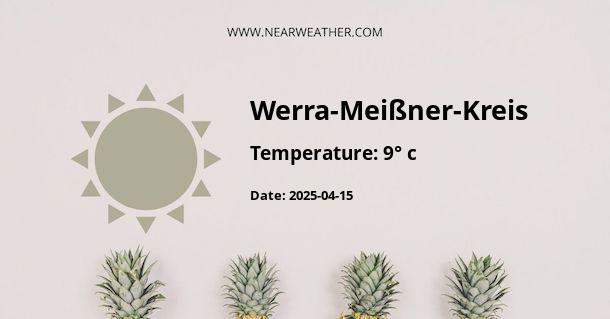Climate and Weather in Werra-Meißner-Kreis, Germany
Werra-Meißner-Kreis is a district in the north of Hesse, Germany, characterized by its varied landscapes, including the Meißner mountains and the Werra River Valley. The climate in Werra-Meißner-Kreis is temperate and seasonal, reflecting the continental influences of Central Europe as well as the region's diversified topography.
Seasonal Climate Overview
The climate in Werra-Meißner-Kreis is classified as a warm and temperate climate with a significant amount of rainfall throughout the year, even in its driest months. According to the Köppen-Geiger climate classification, the region falls under the Cfb category, indicating a temperate oceanic climate.
Spring (March to May)
- Temperature: The average temperatures gradually increase from lows around 0°C in March to highs nearing 20°C by May.
- Precipitation: Rainfall is moderate, with the season experiencing around 40 to 55 mm per month.
- Spring is marked by a mix of sunny, rainy, and occasionally windy days as the transition from winter to summer begins.
Summer (June to August)
- Temperature: Average temperatures range from 15°C to 25°C. Heatwaves can occasionally push temperatures above 30°C but are usually of short duration.
- Precipitation: June receives the highest rainfall of the season, averaging 60 to 70 mm, while the following months see a slight decrease.
- Summer in Werra-Meißner-Kreis enjoys the longest daylight hours and is the most favored season for outdoor activities.
Fall (September to November)
- Temperature: Temperatures begin to cool, averaging between 10°C to 15°C in September, dropping to around 5°C in November.
- Precipitation: There's an increase in rainfall during fall, with November often being one of the wetter months, receiving upwards of 55 to 65 mm.
- The fall foliage in the region's deciduous forests can provide spectacular scenery.
Winter (December to February)
- Temperature: Average temperatures range from -2°C to 3°C. Frost and snow are common, particularly in the higher elevations of the Meißner mountains.
- Precipitation: Snowfall contributes to the precipitation levels, which can average around 40 to 55 mm per month.
- Winter sports are a possibility during this season, especially with proper snowfall in the higher terrain.
Annual Climate Statistics
| Month | Average High (°C) | Average Low (°C) | Average Precipitation (mm) |
|---|---|---|---|
| January | 2 | -2 | 50 |
| February | 3 | -2 | 40 |
| December | 3 | -1 | 55 |
Extremes and Records
A thorough understanding of historical weather patterns is crucial for predicting local weather phenomena. In recent years, with climate change becoming increasingly apparent, Werra-Meißner-Kreis has also witnessed some weather extremes and records, including uncharacteristically hot summers and harsh winters. These extremes are important for agriculturists, ecologists, and city planners within the region to understand and prepare for potentially drastic weather-related impacts.
Climate Influences
The climate in Werra-Meißner-Kreis is influenced by multiple factors, such as its topography and proximity to large bodies of water. The Harz Mountains to the north can have a moderating influence on the weather, protecting the area from colder winds. Moreover, the district's diverse elevation plays a significant role in temperature variation - higher altitudes tend to experience cooler temperatures and more snowfall in winter compared to the lower river valleys.
Environmental and Human Impacts
Climate variations in the Werra-Meißner-Kreis region also reflect broader environmental changes. Human activities, including industry and transportation, urban development, and agricultural practices, contribute to regional climatic shifts. It is essential to monitor these influences to ensure sustainable development and environmental conservation within the district.
Preparation for Seasonal Weather
Residents and visitors in Werra-Meißner-Kreis need to prepare for diverse weather conditions throughout the year. In winter, it is advisable to have winter tires and snow chains available for transportation. Buildings are often designed to withstand the cold months with adequate insulation. Conversely, during summer, preparations include the readiness for heatwaves and managing water resources wisely during periods of lesser rainfalls.
Conclusion
Understanding the climate and weather year-round in Werra-Meißner-Kreis is vital for several sectors, including agriculture, tourism, and local planning. A detailed examination of the seasonal variations and preparation for extreme weather conditions are crucial for the inhabitants and the ecosystem's long-term wellbeing. By keeping abreast of climate trends and historical weather data, stakeholders can make informed decisions that adapt to our changing environment.
A - Werra-Meißner-Kreis's Latitude is 51.207779 & Longitude is 9.938060.
A - Weather in Werra-Meißner-Kreis is 10° today.
A - Climate Conditions in Werra-Meißner-Kreis shows moderate rain today.
A - Humidity in Werra-Meißner-Kreis is 90% today.
A - Wind speed in Werra-Meißner-Kreis is 16.7 km/h, flowing at 265° wind direction. today.
